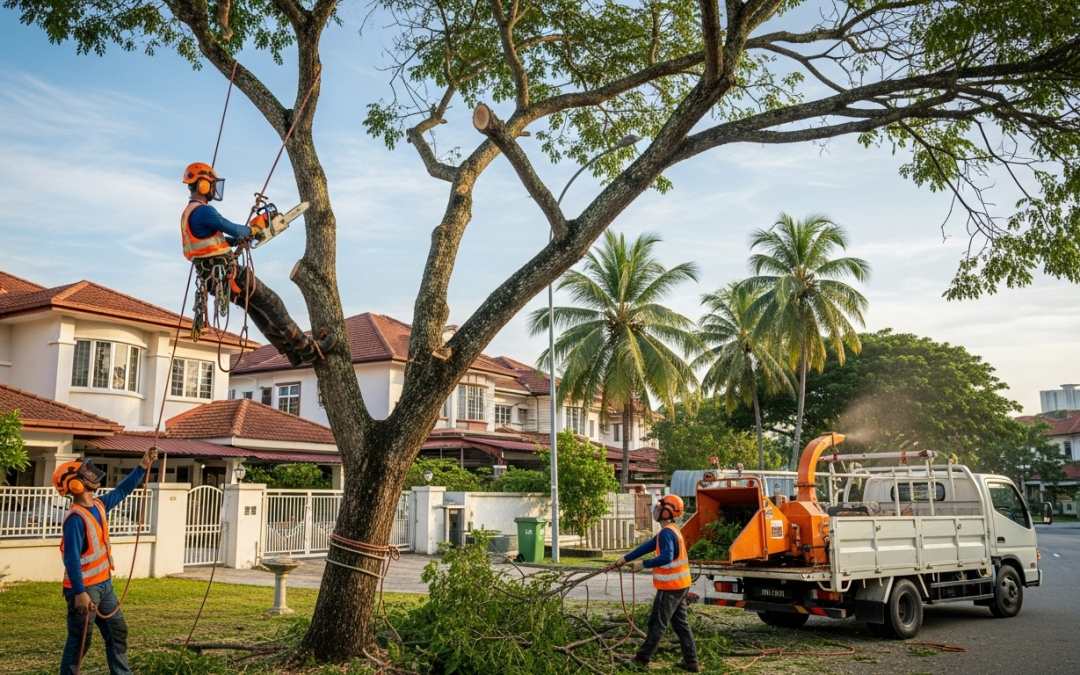In Malaysia’s swiftly advancing urban areas, trees serve not merely as ornamental features—they are an essential component of a city’s infrastructure. From the verdant boulevards of Kuala Lumpur to the green areas of Putrajaya, urban trees deliver essential ecosystem services. Nevertheless, merely possessing trees is insufficient. The expert and informed management of these green resources through professional tree cutting and arboriculture is a vital practice that bolsters urban greenspaces, increases property values, and preserves ecological equilibrium.
1. Supporting Urban Greenspaces and Public Safety
Expert tree maintenance, a field frequently advocated by certified arborists, is crucial for the well-being and security of urban environments in Malaysia.
Hazard Mitigation: The tropical climate of Malaysia, characterized by frequent heavy rainfall and strong winds, can transform a poorly maintained tree into a considerable risk. Engaging in professional tree cutting, which encompasses risk evaluation and the elimination of dead or weak branches, serves as a proactive strategy to avert property damage and safeguard public safety in parks, along roadways, and within residential neighborhoods.
Disease and Pest Management: An expert can recognize and remove sections of a tree that are diseased or infested, thereby stopping the transmission of pathogens and insects that may threaten other trees and plants within the urban greenspace. This practice serves as a preventive healthcare measure for the urban forest, safeguarding its enduring health.
Structural Integrity: Employing appropriate pruning methods, including crown thinning and raising, enhances a tree’s structural stability. This guarantees that the tree is capable of enduring environmental stressors and developing into a robust, healthy specimen, thereby contributing to the overall resilience of the urban canopy.
2. Enhancing Property Values and Community Well-being
A well-maintained and healthy tree canopy represents a valuable asset for any property, and professional tree cutting is essential for maintaining that value.
Aesthetic Appeal: Trees that have been professionally pruned exhibit beauty. They possess a harmonious shape, vibrant leaves, and are devoid of unattractive dead branches. This visual appeal can greatly enhance a property’s marketability and worth, as a well-maintained yard featuring mature, healthy trees is particularly appealing to prospective buyers.
Energy Efficiency: A carefully trimmed tree can offer ideal shade, thereby decreasing the reliance on air conditioning during the sweltering afternoons in Malaysia. This not only reduces energy expenses for homeowners but also aids in creating a cooler, more pleasant microclimate within the community.
Minimized Liability: A property that features trees maintained by professionals is inherently safer. By tackling potential dangers such as weak branches or root problems, a qualified arborist aids in reducing the risk of harm to structures or individuals, thereby protecting property owners from expensive legal and repair costs.
3. Maintaining Ecological Balance
Professional tree cutting involves more than just the act of removing trees; it encompasses the responsible management of a complex ecosystem.
Promoting Biodiversity: By properly pruning a tree, experts guarantee its well-being and lifespan, enabling it to offer a reliable habitat for local wildlife. A thriving tree can support a micro-ecosystem of insects, birds, and various other animals, thereby enhancing urban biodiversity.
Carbon Sequestration: Mature and healthy trees are significantly more efficient at absorbing carbon from the atmosphere compared to young or unhealthy trees. By maintaining urban trees in optimal health, professional arborists enhance their capacity as natural carbon sinks, which is essential in addressing climate change.
The Right Tree, The Right Place: The expertise of a professional arborist includes the selection of suitable tree species for specific locations, taking into account factors such as soil type, spatial limitations, and local ecology. This approach mitigates potential issues and promotes the long-term viability of urban planting initiatives, contributing to the development of a balanced and resilient urban forest.
Conclusion
In Malaysia, where urban development frequently takes precedence, the knowledge provided by professional tree care services has become increasingly vital. This expertise is a crucial element in the pursuit of sustainable, resilient, and livable cities—demonstrating that a thriving urban forest is not a hindrance to advancement, but rather a necessary ally in achieving it.

